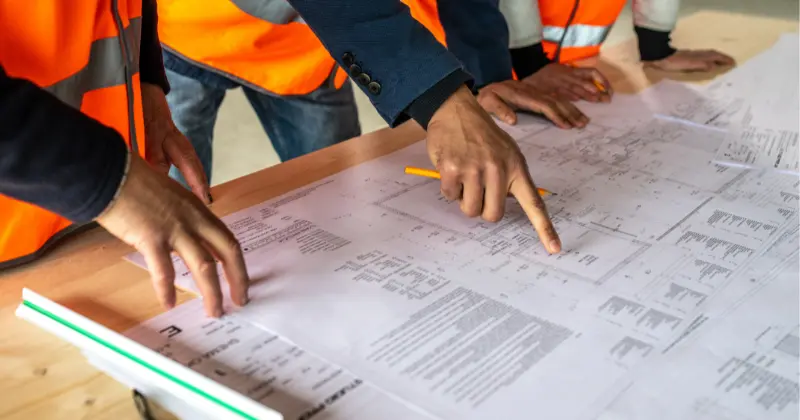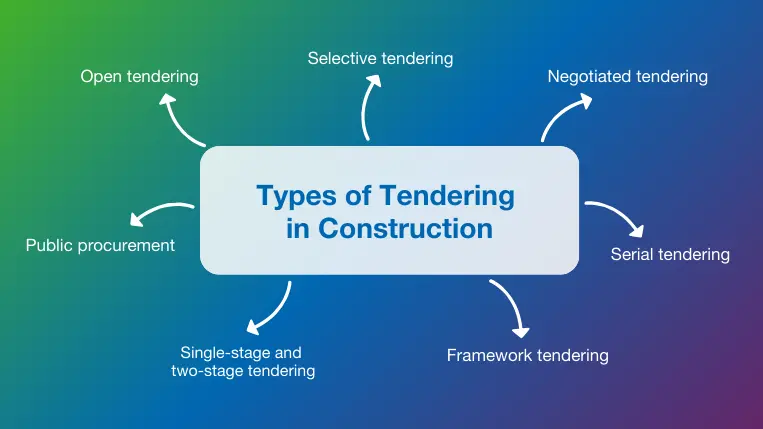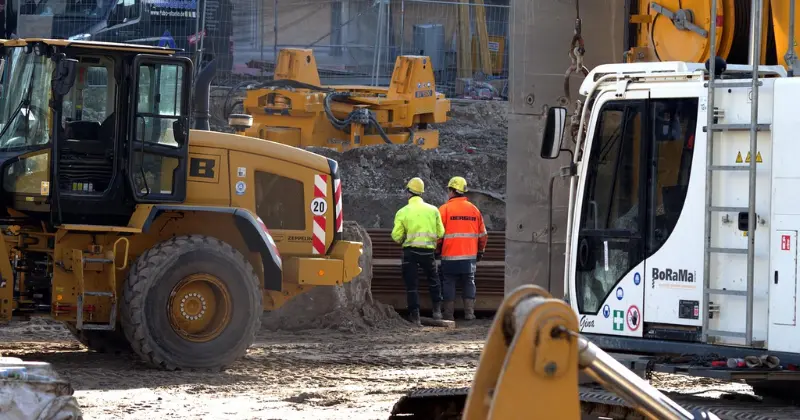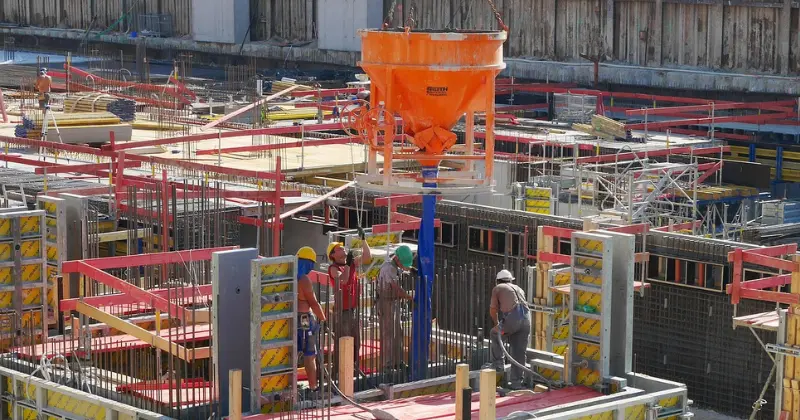10 mins read
The Different Types of Tendering in Construction

Understanding the different types of tendering in construction is essential for project owners to execute and complete a construction project. It will not only help you to make informed decisions but will also enhance operational efficiency and ensure that your project outcome is successful. Whether it’s open tendering, selective tendering, negotiated tendering, or any of the other types of tendering methods, the right knowledge will help you select the most appropriate procurement method for your specific project needs, significantly impacting its overall success.
For those looking to deepen their expertise and increase their chances of winning bids, exploring further insights on how to win a tender can provide valuable strategies.
What is Construction Tendering?
Construction tendering is a process where project owners invite contractors to submit bids for completing a construction project, detailing costs and plans to ensure the best fit in terms of price and capability.
Usually, the tender process starts with an invitation to tender and proceeds with local advertising in the media. Bids from contractors must be turned in by a specific date, detailing the supplies they will provide along with their prices. After a public review based on standards such as cost and quality, the business will select the most appropriate suppliers.
What are the Benefits of Tendering?
In construction, tendering is like attending a grand audition where the finest performers fight to realize a blueprint. This process is about identifying a partner who promises both quality and value – not only about determining the lowest bid.
Through tendering, project owners can choose from a broad pool of contractors who are offering the most creative and reasonably priced solutions. This competitive environment guarantees that only the most qualified and resourceful teams will be selected. Furthermore, the project owner can assess every bid on a shared set of criteria, in so doing guaranteeing fairness and transparency in the sector and ensuring that every participant has a fair chance.
Basically, tendering guarantees that investments turn into durable, high-quality projects created by the most talented hands in the company, so securing the best possible outcome for construction projects.
Types of Tendering in Construction

Project owners and general contractors use different types of tenders for different scenarios. Each type of tender has advantages and disadvantages, and contractors should be aware of these before they decide to bid on a project.
Below, we explain the types of tendering processes in detail, as well as the advantages and disadvantages of each.
1. Open tendering
Out of all the different types of tender in construction, open tendering promotes the most competition. This is because it allows any qualified contractor an opportunity to tender on a project, giving everyone a fighting chance. This is a highly transparent approach and is often used to ensure fairness and competitive pricing in public sector projects. By advertising tenders widely, open tendering encourages a diverse range of contractors to participate, potentially driving down costs due to the competitive nature of the bids.
However, while it allows new and emerging contractors the opportunity to secure projects, it does have its drawbacks. Because open tendering attracts many different suppliers, a lot of them are not suited for the type of work required, which can waste the organization’s time in putting out the tender. In addition, the lowest tender might not be the best fit for the project.
2. Selective tendering
In selective tendering, the project owner normally chooses from a shortlist of trusted, experienced contractors with a good reputation for a specific type of work or their abilities in a particular service. These parties get exclusive invites, which guarantees that the work will be done to a high standard or as intended. In addition, the project owners will waste less time on less experienced contractors, ensuring that only the most competent contractors participate in the bidding process.
The drawback of selective tendering is that it excludes small and inexperienced suppliers who may well be competent contractors. Because there is less competition, this type of tendering process can also lead to higher prices, which is another disadvantage.
3. Negotiated tendering
In negotiated tendering, the project owner chooses one to three suppliers or contractors to submit a tender and negotiates with them until they reach an agreement. The owner can select the contractor(s) from their list of preferences or through the guidance of a professional team.
Negotiated tendering is suitable for highly specialized contracts or where the construction project is urgent, and the work must be fast-tracked. Negotiated tendering involves two phases, namely pre-contract and post-contract negotiations.
The benefit of negotiated tendering is that it can reduce the tendering process and costs and allow the contractor to be involved very early on in the project. It can also minimize the risk of failure since the owner is usually already familiar with the contractor’s work.
However, it significantly reduces the competitive element and limits the availability of work for contractors who are not selected for the tender. Contractors are also likely to quote higher prices than in more competitive tendering processes.
4. Serial tendering
Serial tendering is a process where the owner prepares a set of tenders based on different bills of quantities or work schedules. The rates that the contractors submit can then be used in similar projects happening over a fixed period of time.
The biggest advantage of serial tendering is that a consistent working relationship develops between the owner and the contractor, since he/she understands the owner’s requirements and expectations clearly. This familiarity can lead to improved efficiency, quicker project commencement times, and potentially lower costs due to economies of scale.
However, there are some drawbacks as well. Because a single contractor is locked in for multiple projects, serial tendering can greatly reduce industry competitiveness. This can potentially lead to complacency and less incentive for the contractor to innovate or offer the best possible prices. Additionally, it may limit the owner’s flexibility in adapting to changing circumstances or project needs, as they are contractually tied to one contractor for the duration of the projects.
5. Framework tendering
Framework tendering consists of selecting a contractor or supplier to complete a number of projects over a set time period. It is thus not a contract, but rather a set of guidelines for future contracts.
The primary goal of framework tendering is to speed up the construction procurement process by eliminating the need for buyers to negotiate basic terms each time they commence work on a project. This allows owners to get a quick response to commonly procured goods or services, since the contract has already been signed.
Framework tendering, like many other types of tendering processes, can help clients and contractors build strong relationships, resulting in improved construction site communication and a better understanding of the project’s requirements. It can also result in cost savings due to economies of scale and more consistent pricing.
However, framework tendering can limit competition by not allowing other potentially qualified contractors from bidding on projects during the term of the agreement once the framework has been established. This can limit the client’s flexibility because they are bound by the terms agreed upon with specific contractors, which may not always align with changing project needs or market conditions.
6. Single-stage and two-stage tendering
Single-stage tendering and two-stage tendering are two different types of tendering in construction used in the procurement process to solicit bids from contractors or suppliers.
Single-stage tendering (also known as traditional tendering) involves an owner issuing a tender for the entire project and providing all the relevant information at the point of issue (i.e. in a single stage). This includes detailed design, program information, and cost. The bids are then evaluated, and the successful bidder is awarded a single contract. This type of tender is suitable for projects where the design and scope are well-defined and understood.
While this can be an effective way to get a contractor, there are some disadvantages. Firstly, if elements from the project’s construction specs are missing or unclear, it can lead to the contract needing to be adjusted later, and the final account may look very different as unforeseen costs start to pile up. This added pressure may mean that contractors will start looking for ways to cut costs, which might affect the quality of the project in the long run.
Two-stage tendering breaks the contract down into two phases. In the first phase, the owner selects the contractor who is best suited for the project, and in the second phase, the contract and pricing are finalized between the two parties.
Two-stage tendering is most often used with large and complex construction project types since the design and scope are often not yet fully understood. With these types of tender, the client can better manage the project’s cost, schedule, and quality by allowing for a better understanding of the project and its requirements before the contract is finalized.
While two-stage tendering allows for more flexibility in the procurement process, the bid price may be higher as it involves pre-tender discussions. The process may also be more time-consuming, which may not be appealing to employers with a tight development program.
7. Public procurement
Public procurement is the formal process by which government agencies and public-sector organizations acquire construction services through competitive bidding. This process is governed by strict regulations and guidelines to ensure that public funds are spent fairly, transparently, and accountably. The goal is to deliver public construction projects like roads, schools, and hospitals that provide the best value for money.
The advantage of public procurement is that it encourages competition and ensures that public infrastructure projects are completed to a high standard. In this way, it contributes to community development and welfare.
However, there are some disadvantages: The process can be time-consuming and bureaucratic, with extensive documentation and strict procedures that can cause project delays. Furthermore, if the focus on the lowest bidder is not carefully managed, the quality of the project may suffer.
Conclusion
As the construction industry continues to evolve, staying informed about the above tendering processes is crucial. Whether you are a seasoned contractor or a new project manager, embracing these practices will not only improve your operational efficiency but also significantly contribute to the sustained growth and success of your construction endeavors.
For these complex types of tenders, it is best to have comprehensive construction software solutions to help streamline and simplify processes. A specialized solution such as RIB Tender digitally manages your entire process on the same tendering platform. Our solution supports individual customer needs and all types of tendering processes that are digital. You have full traceability for all actions throughout the tender process, and the tendering authority can review and comment on each bid for simplified preliminary sorting. If you are ready to build better, get a free RIB Software demo today!
Most Recent
10 mins read
10 mins read
11 mins read
10 mins read
Blog Categories

Ebook











